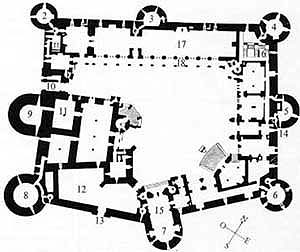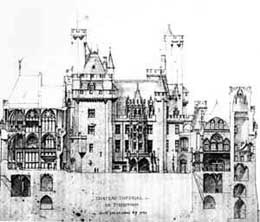|
Description of the castle

- the
defensive structure
The plan of Pierrefonds is composed of a kind of quadrilateral lengthened
of a few 90 m broad on 110 m length, supplemented by a tower with
each angle and one in the medium of each courtine, is on the whole
eight turns of enclosure semi-cylindrical. Each turn was symbolically
allotted to a legendary hero of Antiquity or to a valiant knight
knight of the Middle Ages: Josué. Stiffs, Hector, Alexandre,
Arthur, Charlemagne, Godefroi de Bouillon and finally Jules César.
The latter, most powerful of all, guard the entry of the drawbridge
and is coupled with the strengthened main building: the keep.
One of the defensive systems characteristic of Pierrefonds is a
covered way on double level: that of the turns and that of the courtines.
On the lower floor, machicolations, crenels and archères
make it possible to neutralize the attacker by the jet of varied
projectiles or the shootings of crossbow. A roof in overhang and
gunners posted on the higher floor form an effective protection
against the climbing using scales. In addition, although there was
a difference in level between the stage of the turns and that of
the courtines, the higher gallery of the courtines communicated
with the lower gallery of the turns. This device allowed a fast
circulation and continues all around the fortress according to the
points to defend. This mobility made it possible at the same time
to decrease the importance of the garrison, protected already well
by the almost inaccessible height from the walls.
- a project of imperial residence
 With
the origin. Viollet-the-Duc had considered only the restoration
of the keep, intended to be used as occasional residence for the
emperor. But since 1861; probably allured by the proposals of the
architect, Napoleon III decides to build on the ruins of Pierrefonds
a sumptuous residence, in the spirit of the romantic movement born
thirty years before (with inter alia the publication of Our-Lady
of Paris by Victor Hugo). With
the origin. Viollet-the-Duc had considered only the restoration
of the keep, intended to be used as occasional residence for the
emperor. But since 1861; probably allured by the proposals of the
architect, Napoleon III decides to build on the ruins of Pierrefonds
a sumptuous residence, in the spirit of the romantic movement born
thirty years before (with inter alia the publication of Our-Lady
of Paris by Victor Hugo).
Viollet-the-Duc then conceives a personal and original creation,
which it will not be able completely to complete. Many drawings
and watercolours presented at the castle make it possible to realize
of the neo-gothic atmosphere which he wanted to create. One will
particularly retain the room of Preuses, which was to join together
the personal collection of weapons and armours of Napoleon III.
The faces of "preuses" take as a starting point those
of the empress and by her lady's companions. The room of the empress
is a high arched room, entirely painted, on the second floor of
the Jules-César tower. The living room-anteroom occupies
half of the keep. It is decorated with carved woodworks and a furniture
which already announces "the Art nouveau" of the years
1900.
The vault, an astonishing creation of Viollet-the-Duke, does not
refer to any preexistent model, particularly the rise in a vast
platform arched above the apse. A kind of double apse floods the
nave of light. A number of external details are also treated in
a very personal way by Viollet-the-Duc, in particular:
- large interior
court and its decorated gallery open of vaults to boxes and capitals
historiés with the style rather Rebirth.
- perrons of access.
- the ornamentation
of the frontages, which are connected with stage sets, with its
sculptures of fantastic animals.
Whatever the very personal
additions of Viollet-the-Duc, one must leave him the merit have
ressuscity one of the last strong castles of France and restore
it to us in all his volume five centuries behind. |





 With
the origin. Viollet-the-Duc had considered only the restoration
of the keep, intended to be used as occasional residence for the
emperor. But since 1861; probably allured by the proposals of the
architect, Napoleon III decides to build on the ruins of Pierrefonds
a sumptuous residence, in the spirit of the romantic movement born
thirty years before (with inter alia the publication of Our-Lady
of Paris by Victor Hugo).
With
the origin. Viollet-the-Duc had considered only the restoration
of the keep, intended to be used as occasional residence for the
emperor. But since 1861; probably allured by the proposals of the
architect, Napoleon III decides to build on the ruins of Pierrefonds
a sumptuous residence, in the spirit of the romantic movement born
thirty years before (with inter alia the publication of Our-Lady
of Paris by Victor Hugo). 
